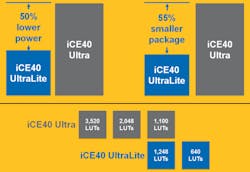Lattice Semiconductor's new, 40-nm iCE40 UltraLite targets mobile devices like wearable technology where low power is king. The iCE40 UltraLite uses half the power and is less than half the size of the iCE40 Ultra (see the figure). The iCE40 Ultra (see “Customizable FPGAs Consume 75% Less Power”) is available with more LUTs (look-up tables) and is designed for higher end applications.
The iCE40 UltraLite uses on-board flash configuration memory. It has up to 26 I/O pins. Three can sink 24 mA, one handles 100 mA and one can handle up to 400 mA. The latter is often used for a white LED to provide a camera flash. These high current pins eliminate the need for off-chip drivers and resistors. Off-chip drivers could consume as much space as the FPGA given is small size.
The chips have up to 1248 LUTs and 56 Kbits of embedded block RAM with a range of hard peripherals that do not use up LUTs. These include four 16 by 16 multipliers with 32-bit accumulators, a pair of I2C interfaces, and an SPI interface. There is a 10 kHz low-power oscillator and a high performance 48 MHz oscillator.
The iCE40 UltraLite is available in a 16-ball WLCSP that is only 1.4- by 1.4- by 0.45-mm. Static power requirements are only 35 µA. Pricing starts at $0.40.
About the Author
William G. Wong
Senior Content Director - Electronic Design and Microwaves & RF
I am Editor of Electronic Design focusing on embedded, software, and systems. As Senior Content Director, I also manage Microwaves & RF and I work with a great team of editors to provide engineers, programmers, developers and technical managers with interesting and useful articles and videos on a regular basis. Check out our free newsletters to see the latest content.
You can send press releases for new products for possible coverage on the website. I am also interested in receiving contributed articles for publishing on our website. Use our template and send to me along with a signed release form.
Check out my blog, AltEmbedded on Electronic Design, as well as his latest articles on this site that are listed below.
You can visit my social media via these links:
- AltEmbedded on Electronic Design
- Bill Wong on Facebook
- @AltEmbedded on Twitter
- Bill Wong on LinkedIn
I earned a Bachelor of Electrical Engineering at the Georgia Institute of Technology and a Masters in Computer Science from Rutgers University. I still do a bit of programming using everything from C and C++ to Rust and Ada/SPARK. I do a bit of PHP programming for Drupal websites. I have posted a few Drupal modules.
I still get a hand on software and electronic hardware. Some of this can be found on our Kit Close-Up video series. You can also see me on many of our TechXchange Talk videos. I am interested in a range of projects from robotics to artificial intelligence.


